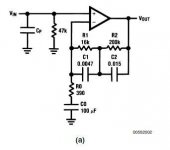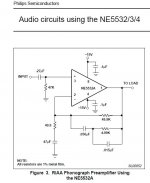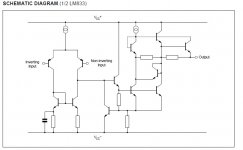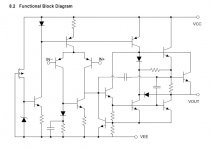That circuit already has the standard 40db of gain at around 1kHz rising to 60db at 20Hz.
Make that 35db and 55db. Dropping the 390 to around 190 ohm will bring the 1k gain up to 40db
... and while your'e at it, increase C0 to 470uF with R0 = 190ohm or C0 = 270uF with R0=390ohm.
C0 = 100uF simply is too small, as it will increase the distortion at low frq, i.e. the low bass will be sloppy.
C0 = 100uF simply is too small, as it will increase the distortion at low frq, i.e. the low bass will be sloppy.
Better to scale up the feedback resistors R1,R2 x2 and the capacitors C1,C2 x0.5, the opamp is driving the 390R at high frequencies and is not up to driving 190R.
The original design was a compromise, make the 390R bigger and it adds noise.
The original design was a compromise, make the 390R bigger and it adds noise.
These values give 40dB gain at 1kHz and are very close to the RIAA curve:
R1=33k
R2=390k
R3=390R
C1=2n2
C2=9n4 (2x4n7 in parallel)
C3=100uF
The original design is not accurate, with a "warm" balance
R1=33k
R2=390k
R3=390R
C1=2n2
C2=9n4 (2x4n7 in parallel)
C3=100uF
The original design is not accurate, with a "warm" balance
Last edited:
The 5532 can drive much lower impedances than a LM35x jfet opamp could.
How well this is worked out is questionable, 50 Ohms is pushing it for the 5532 and with 47uF the bass will be sagging below 100Hz. There will be high levels of 1/f noise due to that capacitor impedance rising at low frequencies.
How well this is worked out is questionable, 50 Ohms is pushing it for the 5532 and with 47uF the bass will be sagging below 100Hz. There will be high levels of 1/f noise due to that capacitor impedance rising at low frequencies.
The current in the feedback return resistor is going to be very small.
At 100Hz and maximum output swing (clipping) it will be in the 100uA region and even at 20kHz and full output will only be around 5 or 6 ma for the 190 ohm version we mentioned earlier.
At 100Hz and maximum output swing (clipping) it will be in the 100uA region and even at 20kHz and full output will only be around 5 or 6 ma for the 190 ohm version we mentioned earlier.
The circuit is from LM833 bipolar opamp app. note. Anyway, I've seen often that Japanese companies use very low values in the feedback circuit. One example is my Yamaha AX592 amplifier that uses 510R feedback and 220R gain setting resistor. OPamp in Yamaha is NJM2068 but I use NJM2114 which is champion among high performance opamps having 60mA output current! Only NJM4556A has more output current but it is special opamp for headphones. 190R gain setting resistor will work in the circuit from post 1 with NJM2114, but what will be the penalty in distortion I don't know.
I doubt distortion would figure much in the scheme of things for the simple reason that levels are way below clipping for normal operation. That means the opamp is not working hard driving the feedback loop.
The LM833 is a actually very good opamp but there are two versions surprisingly.
The current Texas Instruments LM833 uses an NPN quasi complementary output stage to overcome the problems of fabricating high speed 'high power' PNP devices onto the chip and offers better performance the original versions that used a classic NPN/PNP stage.
Texas also offer an LM833-N which does still use the PNP output stage. Also have a look at post #78
About op-amps use.
The LM833 is a actually very good opamp but there are two versions surprisingly.
The current Texas Instruments LM833 uses an NPN quasi complementary output stage to overcome the problems of fabricating high speed 'high power' PNP devices onto the chip and offers better performance the original versions that used a classic NPN/PNP stage.
Texas also offer an LM833-N which does still use the PNP output stage. Also have a look at post #78
About op-amps use.
I think that will be an original type, and as far as I know only Texas has the two types available.
That's interesting to know. They must think it worthy of being revamped like this because it has been around for a few decades now. JLH thought at one time that it could possibly be the best of any (at the time of course).
In fact I am perplexed, it's strange looking schematic.
That will just be an outline rather than a fully drawn schematic. This is the TI version, again its not complete.
Attachments
The differences between makes , like these output stage differences, can make the circuit work with one and not the other. It's odd that the pnp was dropped as making a decent pnp is much easier these days with ion implantation. I remember back 40 years ago when only Harris had a vertical pnp transistor.
- Home
- Source & Line
- Analogue Source
- RIAA circuit help needed



